Hyundai Tucson 2020 - RHD (UK, Australia) Repair Manual
Manufacturer: HYUNDAI, Model Year: 2020, Model line: Tucson, Model: Hyundai Tucson 2020Pages: 637, PDF Size: 64.45 MB
Page 61 of 637
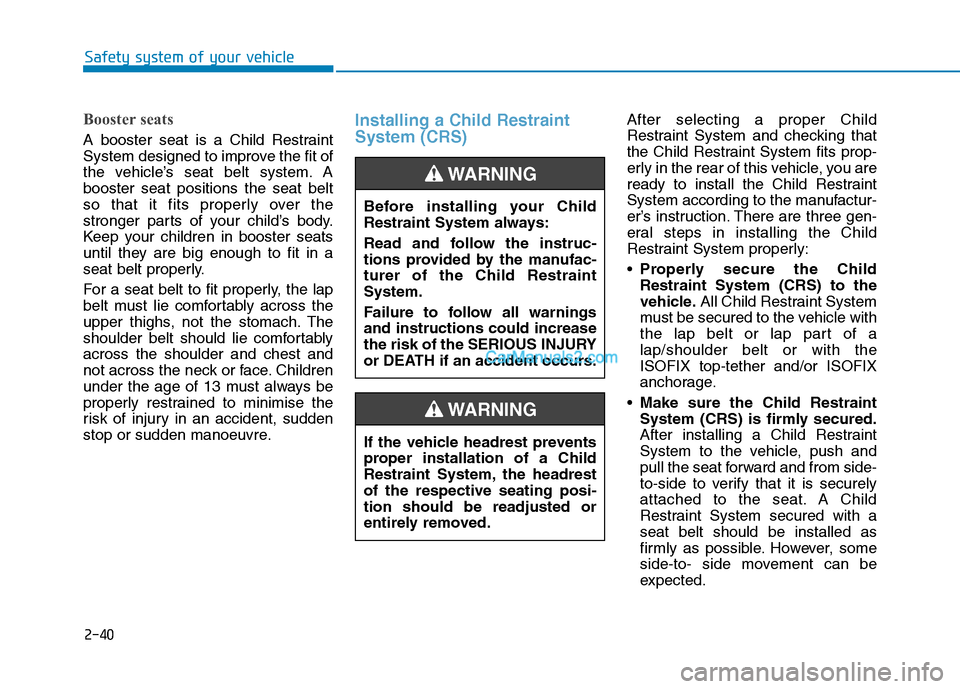
2-40
Safety system of your vehicle
Booster seats
A booster seat is a Child Restraint
System designed to improve the fit of
the vehicle’s seat belt system. A
booster seat positions the seat belt
so that it fits properly over the
stronger parts of your child’s body.
Keep your children in booster seats
until they are big enough to fit in a
seat belt properly.
For a seat belt to fit properly, the lap
belt must lie comfortably across the
upper thighs, not the stomach. The
shoulder belt should lie comfortably
across the shoulder and chest and
not across the neck or face. Children
under the age of 13 must always be
properly restrained to minimise the
risk of injury in an accident, sudden
stop or sudden manoeuvre.
Installing a Child Restraint
System (CRS)After selecting a proper Child
Restraint System and checking that
the Child Restraint System fits prop-
erly in the rear of this vehicle, you are
ready to install the Child Restraint
System according to the manufactur-
er’s instruction. There are three gen-
eral steps in installing the Child
Restraint System properly:
Properly secure the Child
Restraint System (CRS) to the
vehicle.All Child Restraint System
must be secured to the vehicle with
the lap belt or lap part of a
lap/shoulder belt or with the
ISOFIX top-tether and/or ISOFIX
anchorage.
Make sure the Child Restraint
System (CRS) is firmly secured.
After installing a Child Restraint
System to the vehicle, push and
pull the seat forward and from side-
to-side to verify that it is securely
attached to the seat. A Child
Restraint System secured with a
seat belt should be installed as
firmly as possible. However, some
side-to- side movement can be
expected. Before installing your Child
Restraint System always:
Read and follow the instruc-
tions provided by the manufac-
turer of the Child Restraint
System.
Failure to follow all warnings
and instructions could increase
the risk of the SERIOUS INJURY
or DEATH if an accident occurs.
WARNING
If the vehicle headrest prevents
proper installation of a Child
Restraint System, the headrest
of the respective seating posi-
tion should be readjusted or
entirely removed.
WARNING
Page 62 of 637
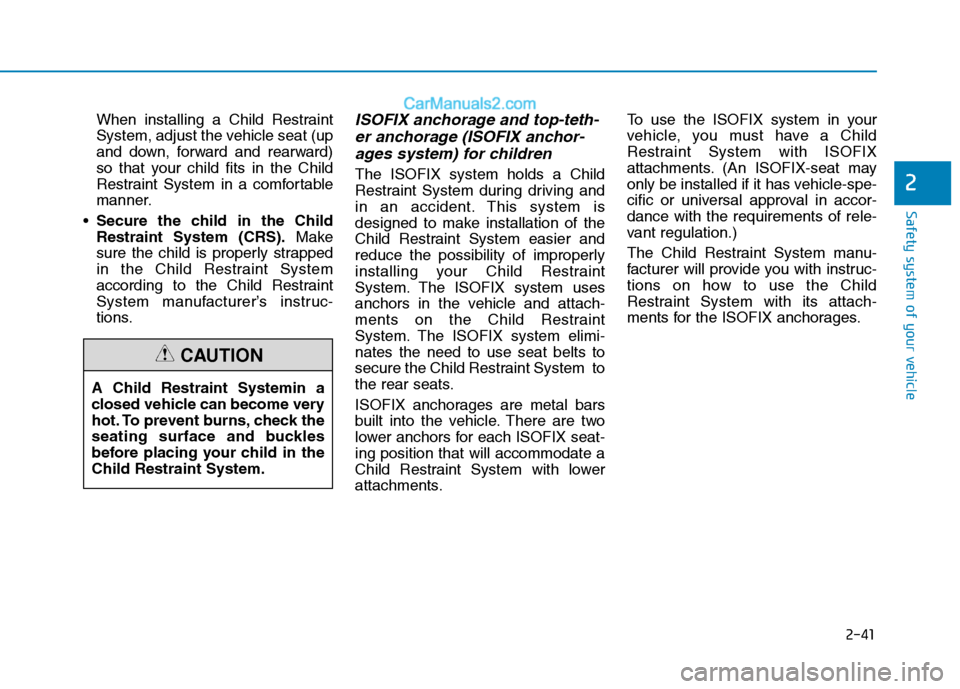
2-41
Safety system of your vehicle
2
When installing a Child Restraint
System, adjust the vehicle seat (up
and down, forward and rearward)
so that your child fits in the Child
Restraint System in a comfortable
manner.
Secure the child in the Child
Restraint System (CRS).Make
sure the child is properly strapped
in the Child Restraint System
according to the Child Restraint
System manufacturer’s instruc-
tions.ISOFIX anchorage and top-teth-
er anchorage (ISOFIX anchor-
ages system) for children
The ISOFIX system holds a Child
Restraint System during driving and
in an accident. This system is
designed to make installation of the
Child Restraint System easier and
reduce the possibility of improperly
installing your Child Restraint
System. The ISOFIX system uses
anchors in the vehicle and attach-
ments on the Child Restraint
System. The ISOFIX system elimi-
nates the need to use seat belts to
secure the Child Restraint System to
the rear seats.
ISOFIX anchorages are metal bars
built into the vehicle. There are two
lower anchors for each ISOFIX seat-
ing position that will accommodate a
Child Restraint System with lower
attachments.To use the ISOFIX system in your
vehicle, you must have a Child
Restraint System with ISOFIX
attachments. (An ISOFIX-seat may
only be installed if it has vehicle-spe-
cific or universal approval in accor-
dance with the requirements of rele-
vant regulation.)
The Child Restraint System manu-
facturer will provide you with instruc-
tions on how to use the Child
Restraint System with its attach-
ments for the ISOFIX anchorages.
A Child Restraint Systemin a
closed vehicle can become very
hot. To prevent burns, check the
seating surface and buckles
before placing your child in the
Child Restraint System.
CAUTION
Page 63 of 637

2-42
Safety system of your vehicle
ISOFIX anchorages have been pro-
vided in the left and right outboard
rear seating positions. Their loca-
tions are shown in the illustration.
There are no ISOFIX anchorages
provided for the centre rear seating
position.The ISOFIX anchorages symbols
are located on the left and right rear
seat cushions to identify the position
of the ISOFIX anchorages in your
vehicle (see arrows in illustration).
Both rear outboard seats are
equipped with a pair of ISOFIX
anchorages as well as a correspon-
ding top-tether anchorage on the
back side of the rear seats.
(CRS with universal approval to rele-
vant regulation need to be fixed addi-
tionally with a top-tether strap con-
nected to the corresponding top-teth-
er anchorage point on the back side
of the rear seats.) Do not attempt to install a Child
Restraint System using ISOFIX
anchorages in the rear centre
seating position. There are no
ISOFIX anchorages provided for
this seat. Using the outboard
seat anchorages, for the CRS
installation on the rear centre
seating position, can damage
the anchorages.
WARNING
OTLE035036
ISOFIX Anchorage
Position Indicator
ISOFIX Lower
Anchorage
OTLE035101R
Page 64 of 637
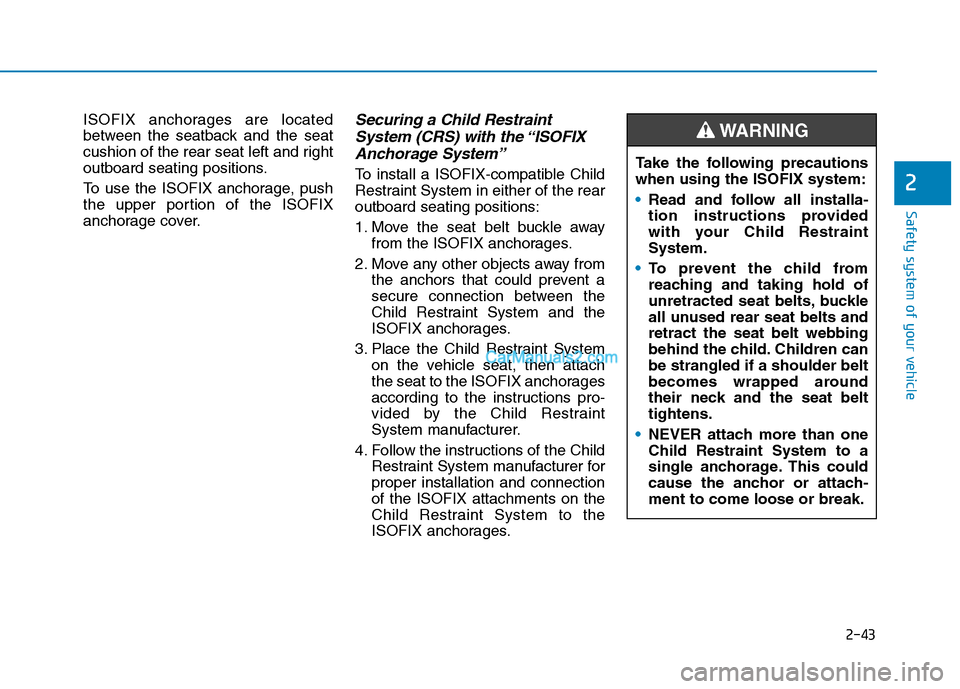
2-43
Safety system of your vehicle
2
ISOFIX anchorages are located
between the seatback and the seat
cushion of the rear seat left and right
outboard seating positions.
To use the ISOFIX anchorage, push
the upper portion of the ISOFIX
anchorage cover.Securing a Child Restraint
System (CRS) with the “ISOFIX
Anchorage System”
To install a ISOFIX-compatible Child
Restraint System in either of the rear
outboard seating positions:
1. Move the seat belt buckle away
from the ISOFIX anchorages.
2. Move any other objects away from
the anchors that could prevent a
secure connection between the
Child Restraint System and the
ISOFIX anchorages.
3. Place the Child Restraint System
on the vehicle seat, then attach
the seat to the ISOFIX anchorages
according to the instructions pro-
vided by the Child Restraint
System manufacturer.
4. Follow the instructions of the Child
Restraint System manufacturer for
proper installation and connection
of the ISOFIX attachments on the
Child Restraint System to the
ISOFIX anchorages.Take the following precautions
when using the ISOFIX system:
Read and follow all installa-
tion instructions provided
with your Child Restraint
System.
To prevent the child from
reaching and taking hold of
unretracted seat belts, buckle
all unused rear seat belts and
retract the seat belt webbing
behind the child. Children can
be strangled if a shoulder belt
becomes wrapped around
their neck and the seat belt
tightens.
NEVER attach more than one
Child Restraint System to a
single anchorage. This could
cause the anchor or attach-
ment to come loose or break.
WARNING
Page 65 of 637

2-44
Safety system of your vehicle
Securing a Child Restraint
System (CRS) seat with “Top-
tether Anchorage” system
Child Restraint hook holders are
located on the rear of the seatbacks.1. Route the Child Restraint System
seat strap over the seatback.
For vehicles with adjustable head-
rest, route the tether strap under
the headrest and between the
headrest posts, otherwise route
the tether strap over the top of the
seatback.
2. Connect the top-tether to the top-
tether anchorage, then tighten the
top-tether according to the instruc-
tions of your Child Restraint
System manufacturer to firmly
attach the Child Restraint System
to the seat.
OTL035034
Always have the ISOFIX sys-
tem inspected by your dealer
after an accident. An accident
can damage the ISOFIX sys-
tem and may not properly
secure the Child Restraint
System.
OTL035035
Page 66 of 637
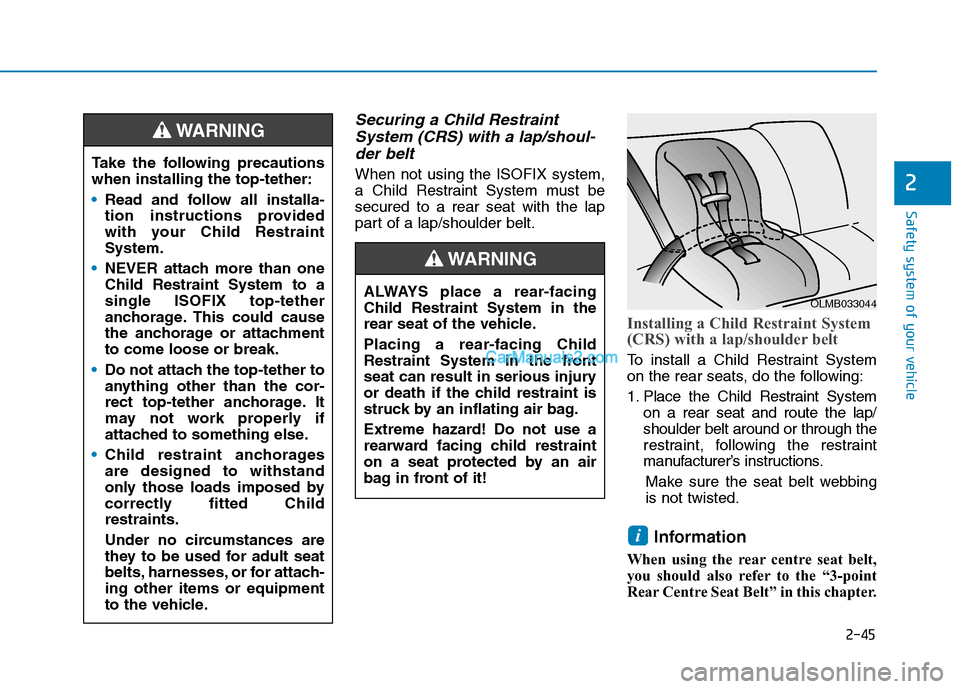
2-45
Safety system of your vehicle
2
Securing a Child Restraint
System (CRS) with a lap/shoul-
der belt
When not using the ISOFIX system,
a Child Restraint System must be
secured to a rear seat with the lap
part of a lap/shoulder belt.
Installing a Child Restraint System
(CRS) with a lap/shoulder belt
To install a Child Restraint System
on the rear seats, do the following:
1. Place the Child Restraint System
on a rear seat and route the lap/
shoulder belt around or through the
restraint, following the restraint
manufacturer’s instructions.
Make sure the seat belt webbing
is not twisted.
Information
When using the rear centre seat belt,
you should also refer to the “3-point
Rear Centre Seat Belt” in this chapter.
i
ALWAYS place a rear-facing
Child Restraint System in the
rear seat of the vehicle.
Placing a rear-facing Child
Restraint System in the front
seat can result in serious injury
or death if the child restraint is
struck by an inflating air bag.
Extreme hazard! Do not use a
rearward facing child restraint
on a seat protected by an air
bag in front of it!
WARNING
OLMB033044
Take the following precautions
when installing the top-tether:
Read and follow all installa-
tion instructions provided
with your Child Restraint
System.
NEVER attach more than one
Child Restraint System to a
single ISOFIX top-tether
anchorage. This could cause
the anchorage or attachment
to come loose or break.
Do not attach the top-tether to
anything other than the cor-
rect top-tether anchorage. It
may not work properly if
attached to something else.
Child restraint anchorages
are designed to withstand
only those loads imposed by
correctly fitted Child
restraints.
Under no circumstances are
they to be used for adult seat
belts, harnesses, or for attach-
ing other items or equipment
to the vehicle.
WARNING
Page 67 of 637

2-46
Safety system of your vehicle
2. Fasten the lap/shoulder belt latch
into the buckle. Listen for the dis-
tinct “click” sound.
Information
Position the release button so that it is
easy to access in case of an emergency.3. Remove as much slack from the
belt as possible by pushing down
on the Child Restraint System
whilst feeding the shoulder belt
back into the retractor.
4. Push and pull on the Child
Restraint System to confirm that
the seat belt is holding it firmly in
place.
If your CRS manufacturer instructs or
recommends you use a ISOFIX top-
tether anchorage with the lap/shoul-
der belt, see page 2-44.To remove the Child Restraint
System, press the release button on
the buckle and then pull the
lap/shoulder belt out of the restraint
and allow the seat belt to retract fully.
If the child seat moves, readjust the
length of the seat belt. In Australia/
New Zealand the child restraint man-
ufacturer's instructions must be fol-
lowed when fitting the unit to the
vehicle.
i
OLMB033045OLMB033046
Page 68 of 637
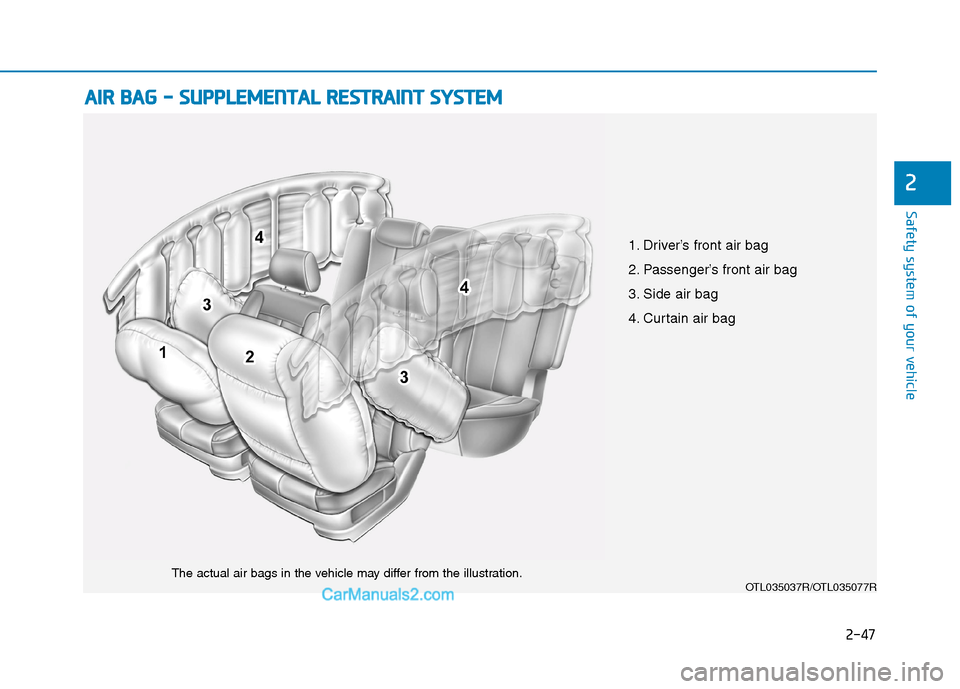
2-47
Safety system of your vehicle
A AI
IR
R
B
BA
AG
G
-
-
S
SU
UP
PP
PL
LE
EM
ME
EN
NT
TA
AL
L
R
RE
ES
ST
TR
RA
AI
IN
NT
T
S
SY
YS
ST
TE
EM
M
2
OTL035037R/OTL035077RThe actual air bags in the vehicle may differ from the illustration.
1. Driver’s front air bag
2. Passenger’s front air bag
3. Side air bag
4. Curtain air bag
Page 69 of 637
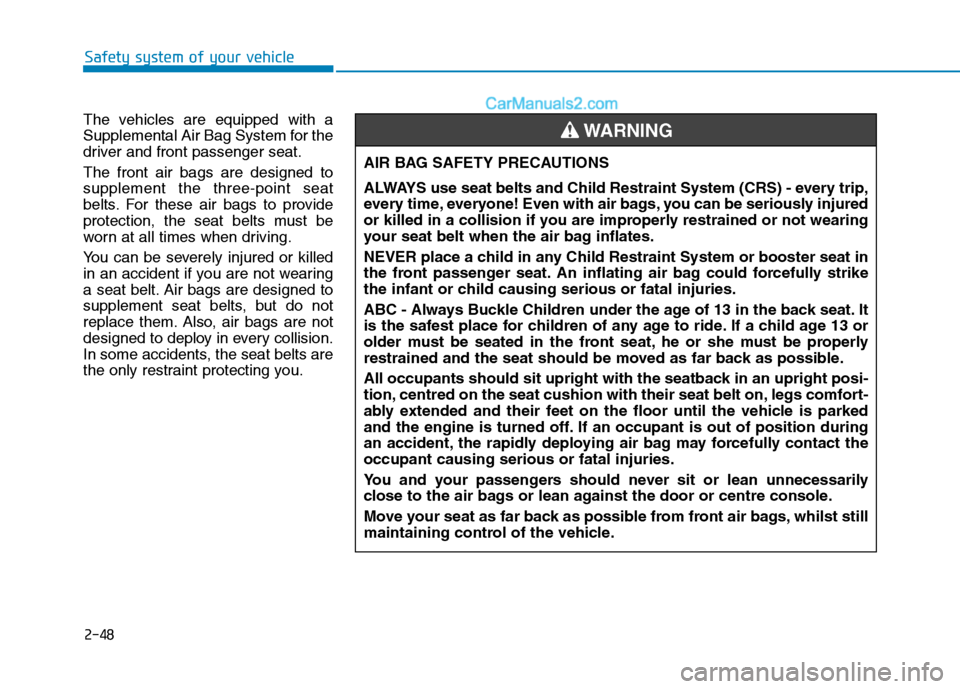
2-48
Safety system of your vehicle
The vehicles are equipped with a
Supplemental Air Bag System for the
driver and front passenger seat.
The front air bags are designed to
supplement the three-point seat
belts. For these air bags to provide
protection, the seat belts must be
worn at all times when driving.
You can be severely injured or killed
in an accident if you are not wearing
a seat belt. Air bags are designed to
supplement seat belts, but do not
replace them. Also, air bags are not
designed to deploy in every collision.
In some accidents, the seat belts are
the only restraint protecting you.AIR BAG SAFETY PRECAUTIONS
ALWAYS use seat belts and Child Restraint System (CRS) - every trip,
every time, everyone! Even with air bags, you can be seriously injured
or killed in a collision if you are improperly restrained or not wearing
your seat belt when the air bag inflates.
NEVER place a child in any Child Restraint System or booster seat in
the front passenger seat. An inflating air bag could forcefully strike
the infant or child causing serious or fatal injuries.
ABC - Always Buckle Children under the age of 13 in the back seat. It
is the safest place for children of any age to ride. If a child age 13 or
older must be seated in the front seat, he or she must be properly
restrained and the seat should be moved as far back as possible.
All occupants should sit upright with the seatback in an upright posi-
tion, centred on the seat cushion with their seat belt on, legs comfort-
ably extended and their feet on the floor until the vehicle is parked
and the engine is turned off. If an occupant is out of position during
an accident, the rapidly deploying air bag may forcefully contact the
occupant causing serious or fatal injuries.
You and your passengers should never sit or lean unnecessarily
close to the air bags or lean against the door or centre console.
Move your seat as far back as possible from front air bags, whilst still
maintaining control of the vehicle.
WARNING
Page 70 of 637
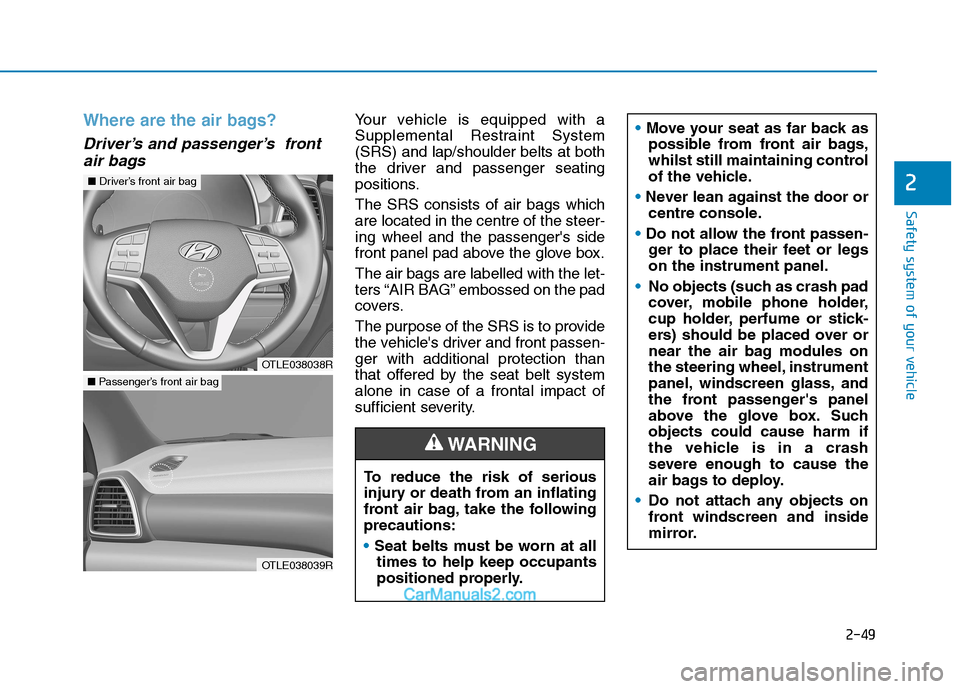
2-49
Safety system of your vehicle
2
Where are the air bags?
Driver’s and passenger’s front
air bags
Your vehicle is equipped with a
Supplemental Restraint System
(SRS) and lap/shoulder belts at both
the driver and passenger seating
positions.
The SRS consists of air bags which
are located in the centre of the steer-
ing wheel and the passenger's side
front panel pad above the glove box.
The air bags are labelled with the let-
ters “AIR BAG” embossed on the pad
covers.
The purpose of the SRS is to provide
the vehicle's driver and front passen-
ger with additional protection than
that offered by the seat belt system
alone in case of a frontal impact of
sufficient severity.
To reduce the risk of serious
injury or death from an inflating
front air bag, take the following
precautions:
Seat belts must be worn at all
times to help keep occupants
positioned properly.
WARNING
Move your seat as far back as
possible from front air bags,
whilst still maintaining control
of the vehicle.
Never lean against the door or
centre console.
Do not allow the front passen-
ger to place their feet or legs
on the instrument panel.
No objects (such as crash pad
cover, mobile phone holder,
cup holder, perfume or stick-
ers) should be placed over or
near the air bag modules on
the steering wheel, instrument
panel, windscreen glass, and
the front passenger's panel
above the glove box. Such
objects could cause harm if
the vehicle is in a crash
severe enough to cause the
air bags to deploy.
Do not attach any objects on
front windscreen and inside
mirror.
OTLE038038R
■Driver’s front air bag
OTLE038039R
■Passenger’s front air bag